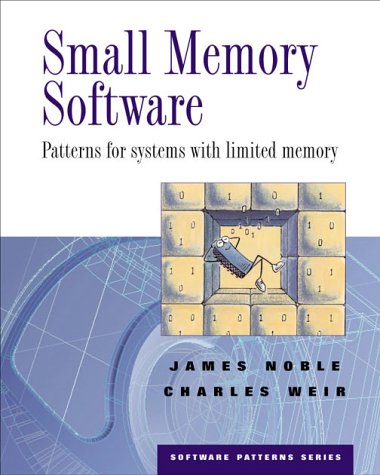
|
FreeComputerBooks.com
Links to Free Computer, Mathematics, Technical Books all over the World
|
|
- Title: Small Memory Software: Patterns for Systems with Limited Memory
- Author(s) Charles Weir and James Noble
- Publisher: Addison-Wesley Professional
- Hardcover: 352 pages
- eBook: PDF and PDF Files
- Language: English
- ISBN-10: 0201596075
- ISBN-13: 978-0201596076
- Share This:

|
The phenomenal increases in processing power and memory capacity of computing hardware over recent years have allowed manufacturers to produce smaller and smaller computer systems such as palmtop PCs, smart cards and embedded control systems on domestic and industrial appliances.
New techniques such as dynamic memory management and object-orientation help programming but tend to require additional memory. Standard programming techniques do not cope with these limited memory-capacity environments.
This book will provide practical help for programmers developing software for this kind of environment. The major content is a series of patterns developed by the authors based on solutions which have been found to work in real-life situations. They range from small system design patterns and process management patterns, to patterns for User Interface development, compression and memory storage.
About the Authors- Charles Weir is a Managing Director of Penrillian, United Kingdom, a software house specializing in porting software to Symbian OS smartphones.
- James Noble is Professor of Computer Science and Software Engineering at Victoria University of Wellington, New Zealand.
 Similar Books:
Similar Books:
-
 Programming Persistent Memory: A Comprehensive Guide
Programming Persistent Memory: A Comprehensive Guide
The book explains fundamental concepts, provides an introduction to Persistent Memory programming APIs for C, C++, JavaScript, and other languages, discusses RMDA with persistent memory; reviews security features; and presents many examples.
-
 What Every Programmer Should Know About Memory
What Every Programmer Should Know About Memory
This document explains the structure of memory subsystems in use on modern commodity hardware, illustrating why CPU caches were developed, how they work, and what programs should do to achieve optimal performance by utilizing them.
-
 Pointers and Memory (Nick Parlante, et al.)
Pointers and Memory (Nick Parlante, et al.)
This is an introduction to programming with pointers and memory in C, C++ and other languages. Explains how pointers and memory work and how to use them -- from the basic concepts through all the major programming techniques.
-
 How Computers Work: Processor and Main Memory, 2nd Edition
How Computers Work: Processor and Main Memory, 2nd Edition
This book starts out very simple and gets more complex as it goes along, but everything is explained. The processor and memory are mainly covered. It explains in great detail the operation of a simple but functional computer.
-
 Memory Management: Algorithms and Implementations in C/C++
Memory Management: Algorithms and Implementations in C/C++
This book presents several concrete implementations of garbage collection and explicit memory management algorithms. Find out how memory is managed at the hardware level by the processor.
-
 Programming Memory-Constrained Networked Embedded Systems
Programming Memory-Constrained Networked Embedded Systems
This book focus on three topics regarding programming memory-constrained networked embedded systems: the TCP/IP, simplifying event-driven, and dynamic loading for memory-constrained systems.
-
 Under the Hood of .NET Memory Management (Chris Farrell)
Under the Hood of .NET Memory Management (Chris Farrell)
This book covers theory and practice for analyzing and improving .NET code performance, with examples and tips, starting with the core concepts of .NET memory management and garbage collection, then additional details and intricacies.
-
 Foundations of Machine Learning (Mehryar Mohri, et al)
Foundations of Machine Learning (Mehryar Mohri, et al)
This book is a general introduction to machine learning. It covers fundamental modern topics in machine learning while providing the theoretical basis and conceptual tools needed for the discussion and justification of algorithms.





